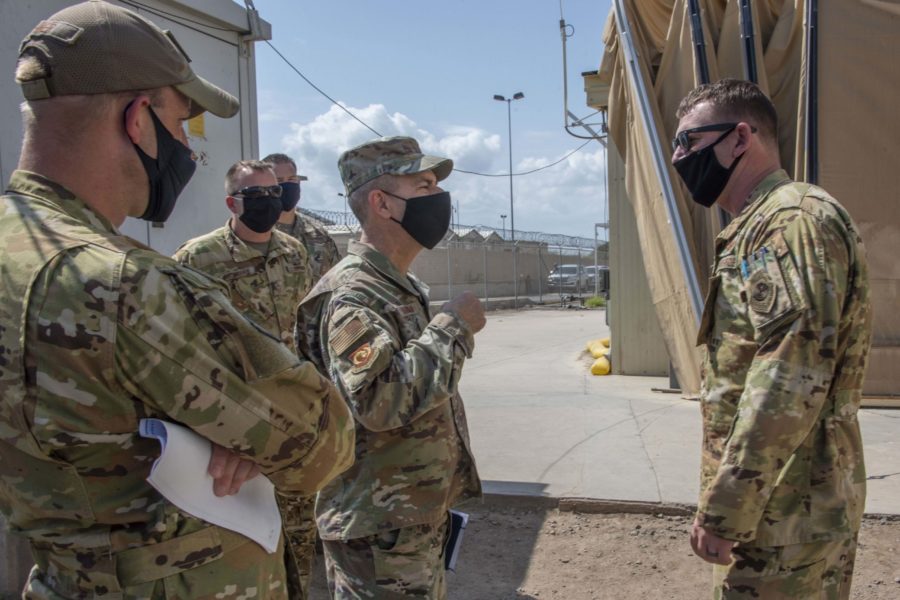AFRICAN AIR CHIEFS SYMPOSIUM, KIGALI, Rwanda—The 10-hour flight on a U.S. Air Force Gulfstream III from Ramstein Air Base, Germany, to Kigali, Rwanda, reminded U.S. Air Forces in Europe-Air Forces Africa chief Gen. Jeffrey L. Harrigian that even a small investment in Africa goes a long way toward advancing American security and building partnerships on the continent.
“I was reminded, as I flew from Germany down here, the size and scope of the continent,” Harrigian told Air Force Magazine in a press briefing following the opening ceremony of the African Air Chiefs Symposium attended by 32 of Africa’s 54 nations.
“As a global Air Force, across the globe, it is clear to me that our investment of people, time, and resources to the continent, broadly—but probably more importantly, to the people that we work with—is well worth the investment,” Harrigian said. “You may not be able to see it in big platforms and those kinds of things. But you see it in the relationships.”
The U.S. Air Force’s priorities in Africa include building partner capacity to fight terrorism, to conduct strategic airlift, and to respond to humanitarian crises.
“We don’t have any partnership like we have with the United States—for training, capacity building,” said Ghana’s air chief, Air Vice Marshal Frank Hanson.
Hanson graduated from the U.S. Air War College at Maxwell Air Force Base, Ala., in 2016, and his air force flies Airbus CASA C-295 twin-turboprop transport aircraft used for tactical airlift, search and rescue, and maritime patrol.
The West African nation is threatened by piracy in the Gulf of Guinea, the instability of its neighbors, and spillover of terrorist affiliates of the Islamic State group and Al Qaeda, such as from neighboring Burkina Faso, site of a coup Jan. 23.
With help from the U.S. Air Force, Ghana is now becoming a regional exporter of security, operating as a peacekeeper with two donated American field hospitals in Sudan.
Even in countries where China is spending and loaning tens of millions of dollars for infrastructure projects and providing military aircraft, the U.S. is still the partner of choice.
“We are under terrorist attack now—we need ISR,” said Benin Air Force Maj. Brice Tobossou, referring to a December 2021 attack by Islamic militants that killed two Army soldiers. Benin flies Chinese turboprop aircraft.
Tobossou, who was at an opening reception table alongside Air Force officers from Togo and Senegal, said the gathering power of the U.S. Air Force helps drive conversations about sharing best practices and operational know-how.
“We need the [US] leadership to put all of us together,” he added, noting how bureaucracy sometimes prevents air chiefs in neighboring nations from talking until they meet in person at AACS, which went virtual for the past two years because of COVID-19.
Some of the more capable air forces in the region are also strong U.S. partners.
Kenya stepped up when former President Donald J. Trump ordered U.S. troops out of Somalia in January 2021, offering to host U.S. trainers working with countries in the region to better fight the terrorist group al-Shabaab.
“The Horn of Africa is a troubled region. The U.S. plays a big role in moderating issues around that area,” Kenya Air Chief Maj. Gen. John Mugaravai Omenda said on the sidelines of the AACS opening ceremony.
“Kenya is a safe haven in the region. And therefore, any insecurity in any country affects our stability, and our security, and our economy as well,” he added.
Omenda said the U.S. military’s knowledge-sharing greatly benefits Kenya.
“We feel that the U.S. is an international strategic partner who we should always be close to and should work closely with,” he added. “Militarily, it’s just beyond the hardware. It’s beyond sharing of knowledge, information, tracking of events, and making sure that everything is in order.”
The close working relationship, and the U.S. troops stationed at the Manda Bay airstrip in Kenya, turned deadly for Americans on Jan. 5, 2020, when a pre-dawn cross-border attack by al-Shabaab killed an American Soldier and two contractors and destroyed five aircraft. It took a dozen U.S. Marines to repel the attack. A Defense Department review of the Manda Bay attack has yet to be released.
“Terrorists—they hit whatever target of opportunity,” Omenda said, noting that lessons learned were put into place to prevent a repeat attack. “It does not deter us or the U.S. from cooperating and keeping the place safe.”
Terrorism is just one concern that African militaries are confronting with U.S. Air Force assistance. Sharing knowledge and intelligence, and training in the United States, are some of the ways the U.S. is advancing partnerships on the continent with limited spending.
Kenya, as one of the wealthier countries in the region, is also becoming a security exporter, conducting training and technological exchanges with its neighbors. Kenya works with Uganda, Tanzania, Zambia, Malawi, and Ethiopia, and it hopes to soon work with Somalia again once that country becomes more stable.
“Running an Air Force for the African nations is not an easy thing,” Omenda said. “It’s an expensive undertaking. And therefore, we encourage sharing of resources.”

